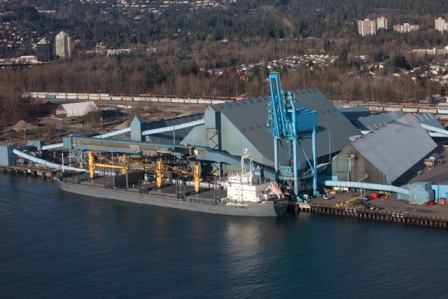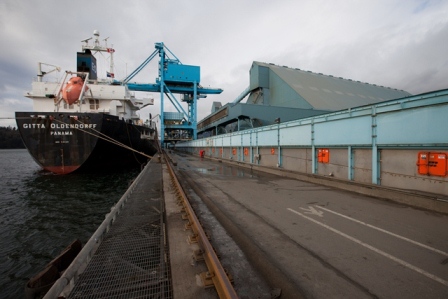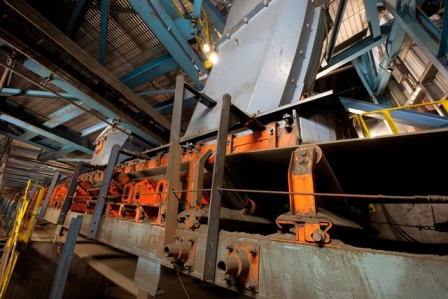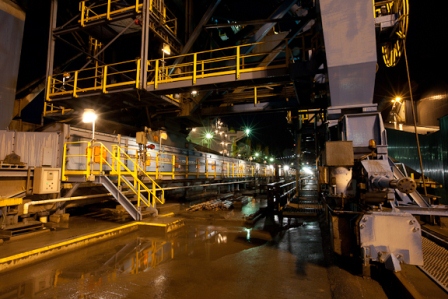Publicado: August 2nd 2016

Kinder Morgan is the largest independent terminal operator in North America, with 180 locations. The Vancouver Wharves terminal in North Vancouver, BC delivers inbound and outbound services to shippers moving cargo to or from all regions of western Canada. The terminal handles mineral concentrates, liquids (diesel and jet fuel), sulphur and specialty agricultural products.
Kinder Morgan has operated the Vancouver Wharves terminal since 2007; the terminal is leased from BC Railways. Environmental stewardship as well as Safety and Quality are three of Kinder Morgan’s core principles. At the terminal all the minerals concentrate storage and handling facilities are fully enclosed to ensure no mineral concentrate escapes into the environment or migrates into the ocean. Kinder Morgan collects and treats all the water used at the terminal prior to discharge into the Burrard Inlet; which includes rainwater run-off, from building roofs, yards as well as from the decks of vessels discharging mineral concentrates at berth #1.
In compliance with Kinder Morgan’s core principal #2 “Environmentally compliant and responsible operator” Kinder Morgan’s Project Manager Al Price-Stephens, knew that rigorous attention to detailed was needed on the Copper Mountain Project. The project would install a load out hopper and four belt conveyers capable of running 1,500mt per hour of mineral concentrate to the existing ship loader at Berth #1. The transfer system needed five belt conveyor transfers which must comply to the “zero spill” principle.

The Terminal handles more than 600,000mt of mineral concentrate per year across five different storage buildings. Environmental stewardship is a fundamental priority at Vancouver Wharves and the mineral concentrates area is fully enclosed to ensure the cleanest bulk handling possible.
Because of Kinder Morgan’s strict environmental standards, company officials knew that particular attention would be needed on the five conveyor transfers in order to prevent the escape of airborne dust. In addition, the seawall directly across from the port includes a prestigious community and park that required protection from dust and other effluent.
“When we spent some time reviewing the existing transfer points, it became apparent that there was new and better technology available,” said K-M Engineering & Project Development Manager Al Price-Stephens. “Rather than using a general engineering contractor to design the new conveyors and transfers, we wanted equipment that could elevate the performance and containment to a new level,” he said.
During initial meetings, the Martin Engineering team introduced a variety of new technologies to improve efficiency and dust containment. “They helped us reach a good understanding of what’s available, and we found additional details on the company’s web site,” Price-Stephens continued. “We also became very familiar with the Martin Engineering book, Foundations IV, which has become the bible of bulk materials handling.”
To address the site’s specific requirements and design appropriate containment, Martin Engineering conducted a site survey, which was followed by a conveyor risk assessment in 2010. The strategy that emerged gave Martin Engineering responsibility for the design and fabrication of the five transfers, as well as supervising the installation by an outside contractor.

“Load zones and discharge points are prime sources for the creation and release of airborne dust,” explained Martin Engineering Global Projects Manager Greg Bierie. “The amount of dust created in a transfer point depends on a number of factors, including the nature of the material and the height of the drop onto the belt, as well as the speed and angle of the loading and unloading belts,” he said.
The project was kicked off with material testing at Martin Engineering’s Center for Innovation at the company’s headquarters in Neponset, IL. “By testing the customer’s specific bulk material and applying those properties as the initial step in chute design, we can develop a transfer that maximizes capacity, while minimizing the potential for build-up and fugitive material,” Bierie said.
The new transfer points make use of Martin’s Transfer Chute Technology, the entire chute custom-engineered and modeled in 3-D to provide the optimum design for the material and flow rate needed. Four of the new transfer points employ a “hood and spoon” transfer, with the hood discharge chute at the top of the system and a spoon receiving chute to place material onto the belt being loaded. The engineered flow chutes employ special geometries that capture and concentrate the material stream as it travels through the chute. The fifth transfer point required a heavy-duty impact area at the bottom of a hopper to handle cargo from two front loaders.
The Martin Engineering team presented the conceptual models during a meeting with Kinder Morgan, in which the topics of discussion included proposed system operation, mechanical requirements, belt cleaners, schedule, site-specific training and project documentation. K-M personnel were so impressed that they approved the conceptual models almost immediately.
Weekly meetings were held from the beginning of the project through final design, which allowed all participants to see and discuss the status of each transfer point as it was being designed. “Every chute design is tailored to suit the specific material characteristics and conveyor systems of the individual customer, rather than using stock products and attempting to make them work,” observed Martin Engineering Projects Manager Tim Patrick O’Harran.
“The hood minimizes expansion of the material stream, directing it downward,” O’Harran explained. “The spoon provides a curved loading chute for a smooth line of descent, consistently feeding the material at a specific speed and direction to minimize impact in the loading zone.”
The goals of the Martin Transfer Chute are to confine the material stream and reduce air entrainment, while directing the moving material onto the receiving belt with minimal impact. Successful designs reduce spillage, abrasion, dust and premature wear. This control also helps ensure that material is center-loaded on the belt, avoiding mis-tracking and fugitive dust. Martin Transfer Chutes provide the dual benefits of minimizing aeration and preventing buildup within the chute, which is particularly important when dealing with combustible materials.
To fabricate the transfer chutes and custom load zone components, Martin Engineering was able to take the SolidWorks™ models and develop fabrication drawings directly from them, which accelerated the transition from design to fabrication. Delivery of the transfer chute components was completed incrementally over a period of several weeks from March through June 2011.
Initial plans for the material handling system called for ship loading to begin in Q2 of 2012, so Martin Engineering agreed to a fast-track schedule. As the project progressed, Kinder Morgan requested that the schedule be accelerated even further. Although this presented some challenges, the Martin Engineering team met all deadlines.

“Martin engineering works in a 3D model concept, which not all designers do,” Price-Stephens said. “It’s much easier to look at a 3D model, and easier to resolve some of the potential issues before fabrication. Martin Engineering took on all the fabrication and got the components here to meet our schedule, which was constantly evolving. Then they were here throughout the installation, as well.”
The six new conveyors range from 105 feet (~32 meters) to 709 feet (216 meters) in length. Three are 42" wide (106.68 cm), and three are 48" (122 cm). Average speeds range from 177 feet per minute (0.9 meters per second) on the shortest run to 565 FPM (2.87 MPS) on the longest conveyor. Liner materials were installed on all five transfer chutes to resist abrasion and extend service life. At initial start-up, the system provided throughput of 900 MTPH, and with some fine-tuning, engineers have been able to raise that figure to 1,200 MTPH.
Asked to summarize the experience overall, Price-Stephens said, “We were pleased by the level of support that we received from Martin Engineering, without having to hound anyone. And we were impressed by the fact that when we did the initial start-up in December of 2011, it was the guys who helped design the equipment who were there to oversee the start-up.
“To some extent, I think bulk terminals like ours have learned to live with a certain amount of spillage and dust, believing that it’s unavoidable,” he added. “We’ve proven here that isn’t the case.
“When you look at the components and see what’s been designed for this facility, you realize the concepts and technology are pretty straightforward,” Price-Stephens continued. “It’s really about simple things done well.”